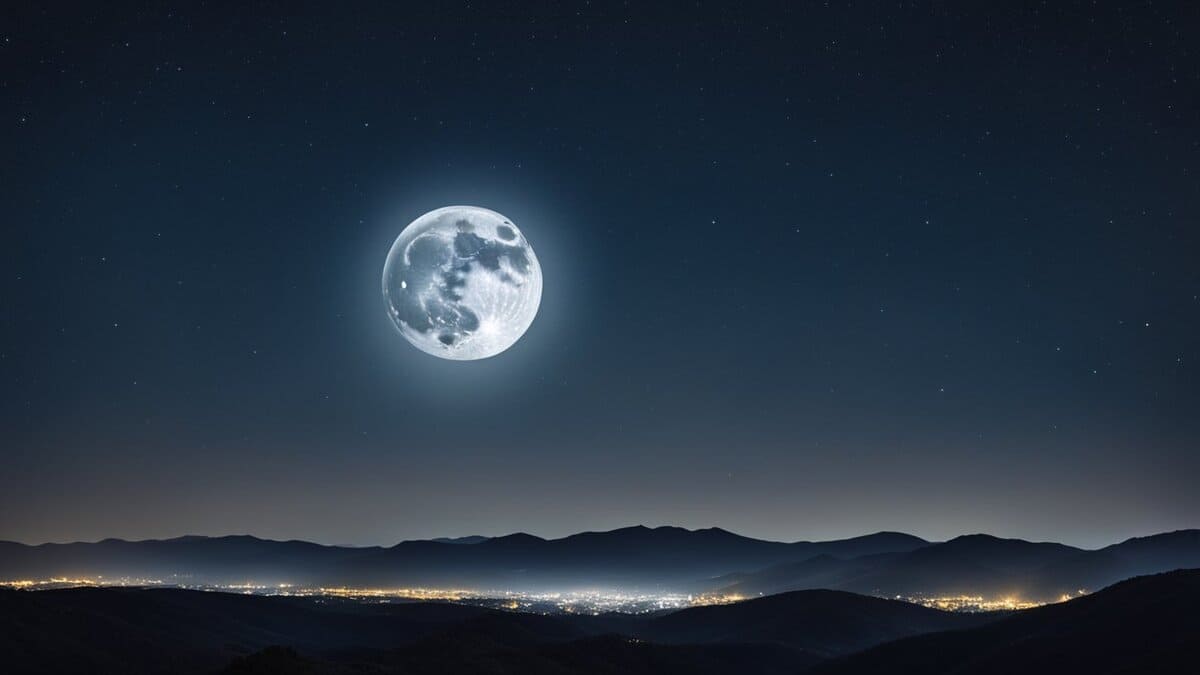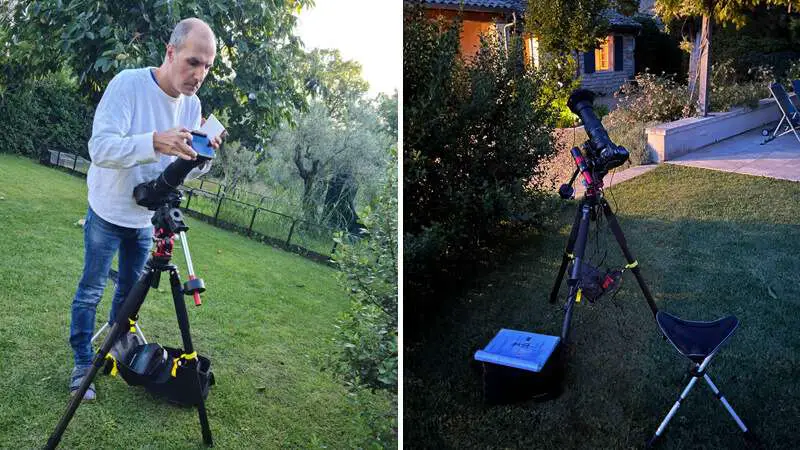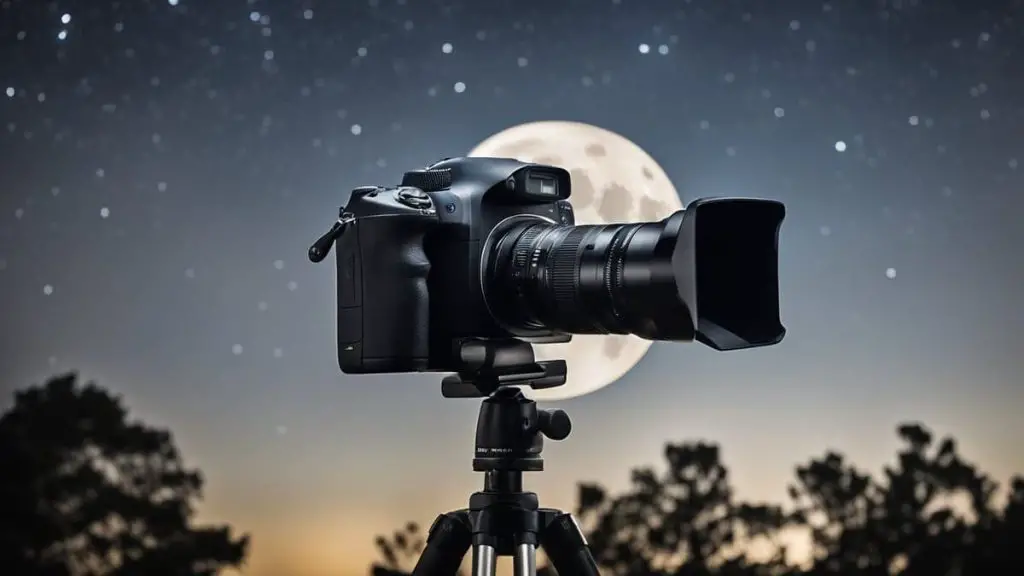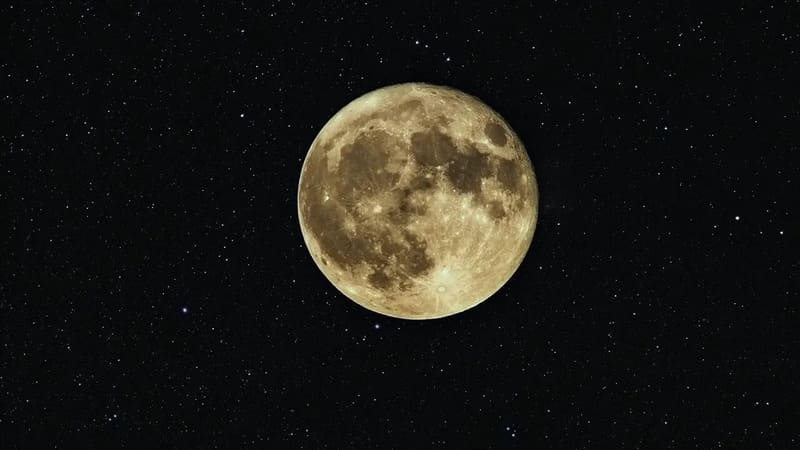You’re captivated by the allure of astrophotography, especially under the full moon’s mesmerizing glow. The full moon phase, with its unique brightness and detail, offers an exceptional canvas for night sky photography.
However, capturing the celestial beauty during a full moon comes with challenges. The intense brightness can overshadow faint stars, while added light pollution complicates capturing clear night sky photos. Navigating these obstacles can seem daunting. Hence the question, “Can You Do Astrophotography with a Full Moon?”
I’ve tailored this article to equip you with the knowledge and techniques to master astrophotography in full moon conditions. From selecting the right equipment to adjusting your camera settings and employing post-processing strategies, you’ll find actionable solutions to enhance your lunar photography skills. Gear up to transform these challenges into stunning captures.
Key Things to Know:
- The full moon phase offers unique conditions but poses challenges for capturing faint celestial objects due to its brightness.
- Essential gear includes a DSLR or mirrorless camera, a telephoto lens, a tripod, and potentially a telescope with an adapter.
- Adjusting ISO, exposure time, and using filters can significantly improve full moon astrophotography results.
Introduction: Can You Do Astrophotography with a Full Moon?

The phase of the moon plays a crucial role in astrophotography, affecting which celestial objects you will be able to photograph. In my years of astrophotography, I’ve seen firsthand how the moon’s phase can make or break a night’s shoot.
Significance of the Full Moon for Night Sky Photography
A full moon is when the moon is fully illuminated by the sun. This phase provides unique conditions for night sky photography:
- Bright illumination: The full moon is bright, casting a glow that has allowed me to create dramatic nightscapes.
- Highlighting features: The full moon’s light can bring out details on the moon’s surface.
Challenges of Photographing During Full Moon
In my experience, astrophotography during a full moon poses certain unique challenges:
- Faint object visibility: Bright moonlight can overpower the light from faint stars, galaxies, and nebulae.
- Increased light pollution: The glow of a full moon adds to light pollution, making it harder to capture clear photos of the night sky.
Understanding the moon phase is essential for planning your photography sessions.
Here are the phases you should know:
- New moon: The best time for astrophotography, as the sky is darkest.
- Waxing crescent: A small part of the moon is illuminated, growing each night.
- First quarter: Half of the moon is lit up.
- Waxing gibbous: The illuminated part continues to grow.
- The last quarter and waning phases (waning gibbous and waning crescent) lead back to the new moon, with decreasing illumination each night.
For astrophotography, aim for times near the new moon or during the waning phases when the sky is darker.
Equipment Essentials for Successful Moon Photography

When you aim to capture the moon’s beauty, you’ll need the right gear. Let’s talk about what you’ll need.
Choosing the Right Camera and Lens
The camera is your most important tool. For sharp moon photos, look for a DSLR or mirrorless camera. I’ve achieved some of my clearest moon shots using a trusty DSLR, and I wouldn’t go without it.
These cameras let you change lenses and settings, which is vital in astrophotography. Use a telephoto lens to zoom in close or a telephoto zoom lens for more flexibility. If you have an APS-C camera, your lens will make the moon look even bigger, which is a fantastic bonus.
The Role of Telescopes and Adapters
I’ve found that sometimes, more than a camera lens is needed to capture the moon’s intricate details. A telescope acts like a giant lens, giving you an up-close view of the moon. To connect your camera to the telescope, you’ll need an adapter. Make sure the adapter fits your camera model to avoid any shaky shots.
Importance of a Steady Tripod and Tracking Mount
To keep your camera still, I’ve always relied on a sturdy tripod. It’s like a third hand that never gets tired. If you want to get fancy, use a tracking mount. It moves the camera at the same speed as the moon, so your picture stays sharp, and the moon doesn’t blur as it moves across the sky.
Here’s what to remember:
- Pick a DSLR or mirrorless camera.
- Zoom in with a telephoto lens.
- For more moon detail, attach your camera to a telescope.
- Keep everything stable with a tripod.
- A tracking mount helps for long exposures.
Now, gear up and get ready to shoot for the stars! Or, well, the moon in this case.
FREE STARGAZING CHECKLIST
My 5-page Stargazing Checklist will enhance your astronomical observations.
Follow this free checklist to navigate the night sky with confidence, clarity, and a sense of preparedness for a rewarding stargazing experience.

Camera Settings and Techniques for Full Moon Conditions

Capturing the moon’s beauty during a full moon can be tricky, but you can get stunning photos with the proper camera settings and techniques.
Optimizing ISO and Exposure Time
- I keep my ISO low, around 100 or 200, to avoid grainy photos, as I’ve found this to be the sweet spot. My particular camera is ISO-invariant, so increasing ISO only reduces dynamic range, which I don’t want.
- Use a shutter speed between 1/125sec and 1/250sec to prevent motion blur and overexposure.
Astrophotography in full moon conditions is different from that of a new moon. You’re dealing with much more light, so adjusting the ISO and exposure time is critical to a clear shot of the moon.
Utilizing Filters for Better Image Quality
- An H-Alpha (Ha) filter can let you photograph even during a bright full moon.
- Some photographers use an L-Pro filter to reduce unwanted light and improve contrast.
If you have a DSLR camera, consider adding a narrowband filter. This helps manage the extra brightness a full moon brings. Remember that the right filter can make the difference in your shots. Learn how a narrowband filter can improve your astrophotography.
Focusing Techniques for Sharp Lunar Details
- I’ve always used manual focus to gain more control over the sharpness of the lunar details.
- Turn on live view mode if your camera has it, and use focus peaking to highlight areas in focus.
Getting the focus right is essential. The moon moves, and auto-focus might not keep up. That’s why manual focus can give you crisp, sharp lunar details. Also, setting your aperture between f/5.6 and f/11 can help get a sharp image without overexposing it.
Check out tips for setting your camera up for moon photography at Nikon (I use a 10+ year-old Nikon D600).
Remember, patience and practice make perfect. Try different settings and techniques until you find what works best for your equipment and the current conditions.
Post-Processing Strategies to Enhance Moon Photographs

When taking photos of the moon, you may face challenges like a bright full moon washing out finer details. But with the right post-processing strategies, you can bring out the best in your moon photographs.
Editing with Adobe Photoshop
After many nights spent under the stars, I’ve learned that Photoshop is essential for revealing the moon’s hidden details.
Here’s how you can enhance those lunar details:
- Adjust the contrast to make features pop.
- Tweak brightness to reveal surface details.
Remember to work with RAW files for maximum control over your image quality.
Noise Reduction and Clarity Improvements
Moon photos can get grainy – that’s noise. Clear it up with these steps:
- Zoom in and spot the noisy areas.
- Use the ‘Reduce Noise’ filter in Photoshop for a cleaner image.
Boost the clarity to sharpen the edges around craters and ridges for a more defined moon surface.
Stacking and Exposure Blending Techniques
Stacking multiple photos can reduce noise and improve detail. Here’s how to do it:
- Take several shots of the moon in quick succession.
- Use software that aligns and stacks images, like Adobe Photoshop.
By blending exposures, you can balance your moon photos’ light and dark areas, making them look even better.
Planning and Composing Your Moon Astrophotography Session

When you aim to take stunning photos of the moon, knowing where to set up and how to frame your shot are keys to success. Let’s get you ready to capture the moon’s beauty with some smart planning and composition tips.
Selecting the Ideal Location and Timing
Finding the Perfect Spot:
- Pick a location far from city lights for darker skies.
- Use a planetarium app to predict where the moon will be in the sky.
When to Shoot:
- Check the weather for clear skies.
- Plan around the moon’s phase; a full moon is very bright and can limit the visibility of other celestial objects.
Composition Principles for Compelling Imagery
Using the Rule of Thirds:
- Imagine your shot is divided into nine equal segments by two vertical and two horizontal lines.
- Place the moon on one of the points where the lines intersect for a more exciting photo.
Composition Tips:
- Balance the composition by including interesting foreground elements.
- Try different angles with your point-and-shoot camera or smartphone to find the best view.
Frequently Asked Questions
How do you capture the colors of the night sky during a full moon?
Capturing the vibrant colors of the night sky during a full moon involves using a lower ISO to reduce noise and experimenting with different shutter speeds. This approach helps preserve the natural hues of the night sky against the moon’s brightness.
What’s the best way to plan an astrophotography session during a full moon?
The best way to plan an astrophotography session during a full moon is to use apps that track lunar phases and weather conditions. This ensures you’re shooting under optimal conditions, with clear skies and the moon in the desired phase for your photography goals.
Can you do astrophotography with a smartphone during a full moon?
Yes, you can do astrophotography with a smartphone during a full moon using manual mode or a dedicated astrophotography app to adjust settings like ISO and shutter speed. Adding a clip-on telephoto lens can also enhance your smartphone’s capabilities for capturing the moon.
TL;DR
- The full moon phase presents unique opportunities and challenges for astrophotography due to its bright illumination.
- Essential equipment includes a DSLR or mirrorless camera, a telephoto lens, a telescope with an adapter, and a stable tripod.
- Adjusting ISO and exposure time and using specific filters are vital in capturing detailed and clear full-moon photographs.
- Manual focus and specific camera settings are crucial for achieving sharp lunar details during a full moon.
- Post-processing techniques like adjusting contrast and noise reduction can significantly enhance moon photographs.
Your curiosity fuels my passion for astrophotography, and I’m here to share insights from my journey. If you have questions or thoughts, I’d love to hear them. Let’s start a conversation below.




